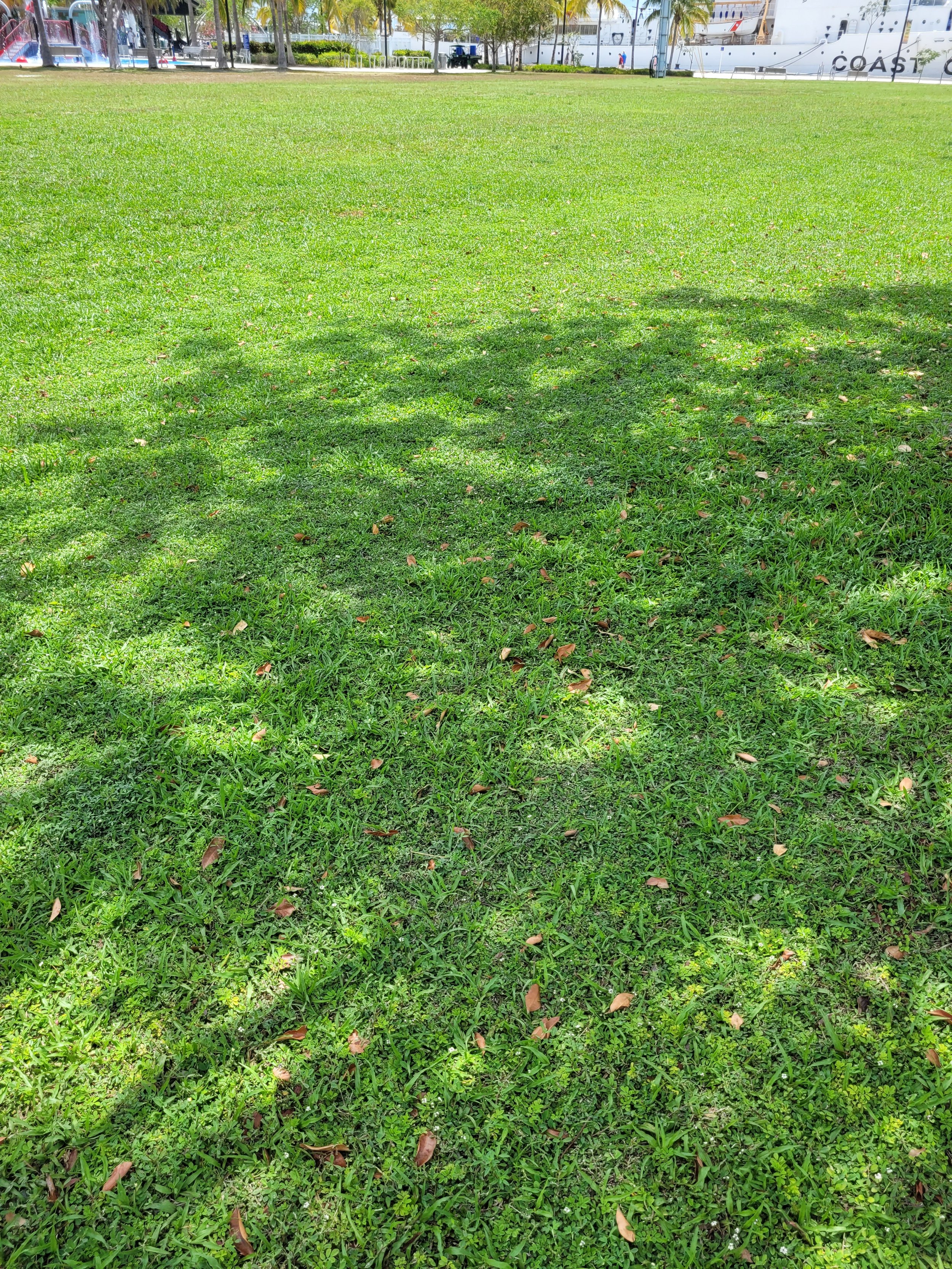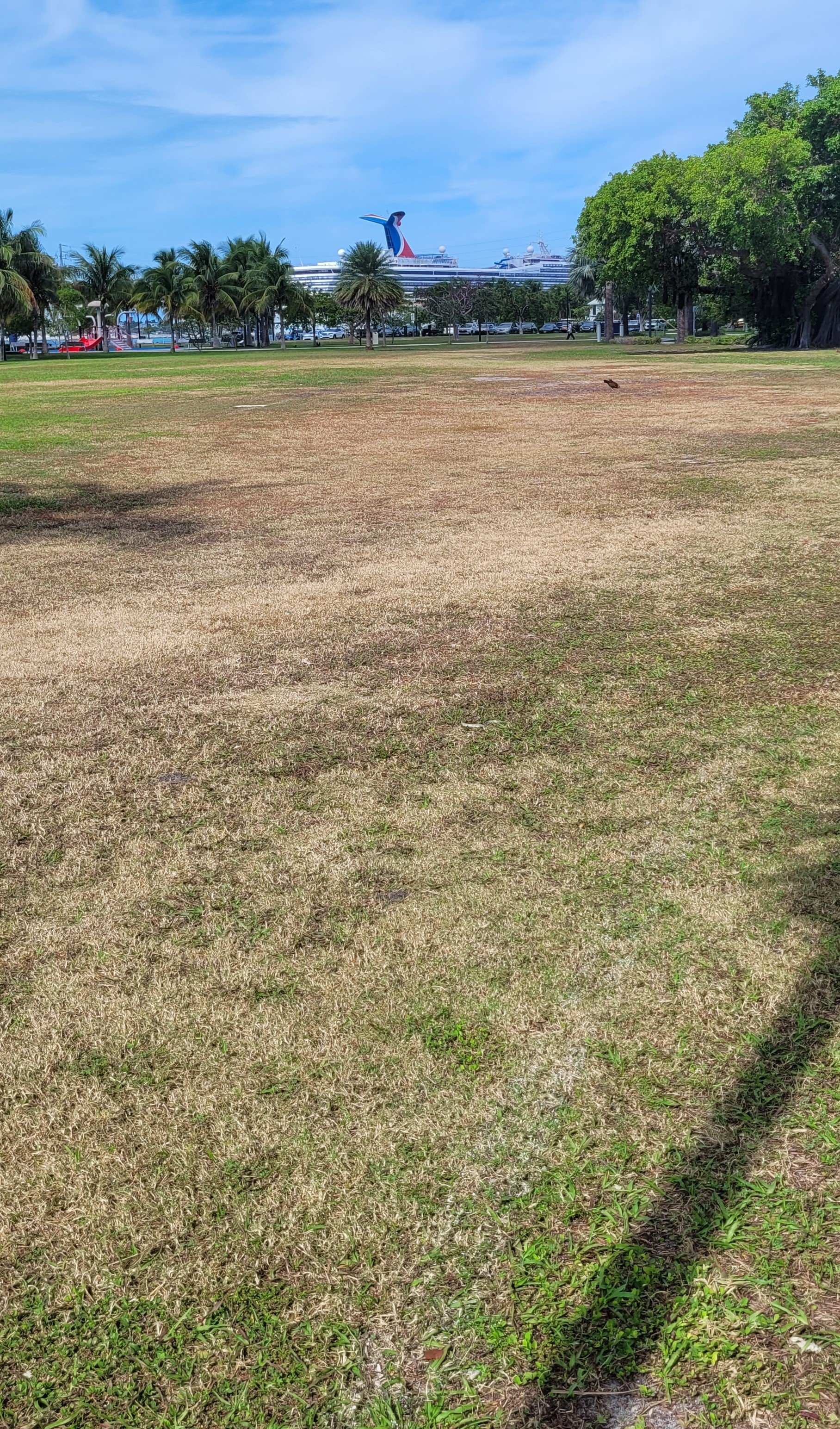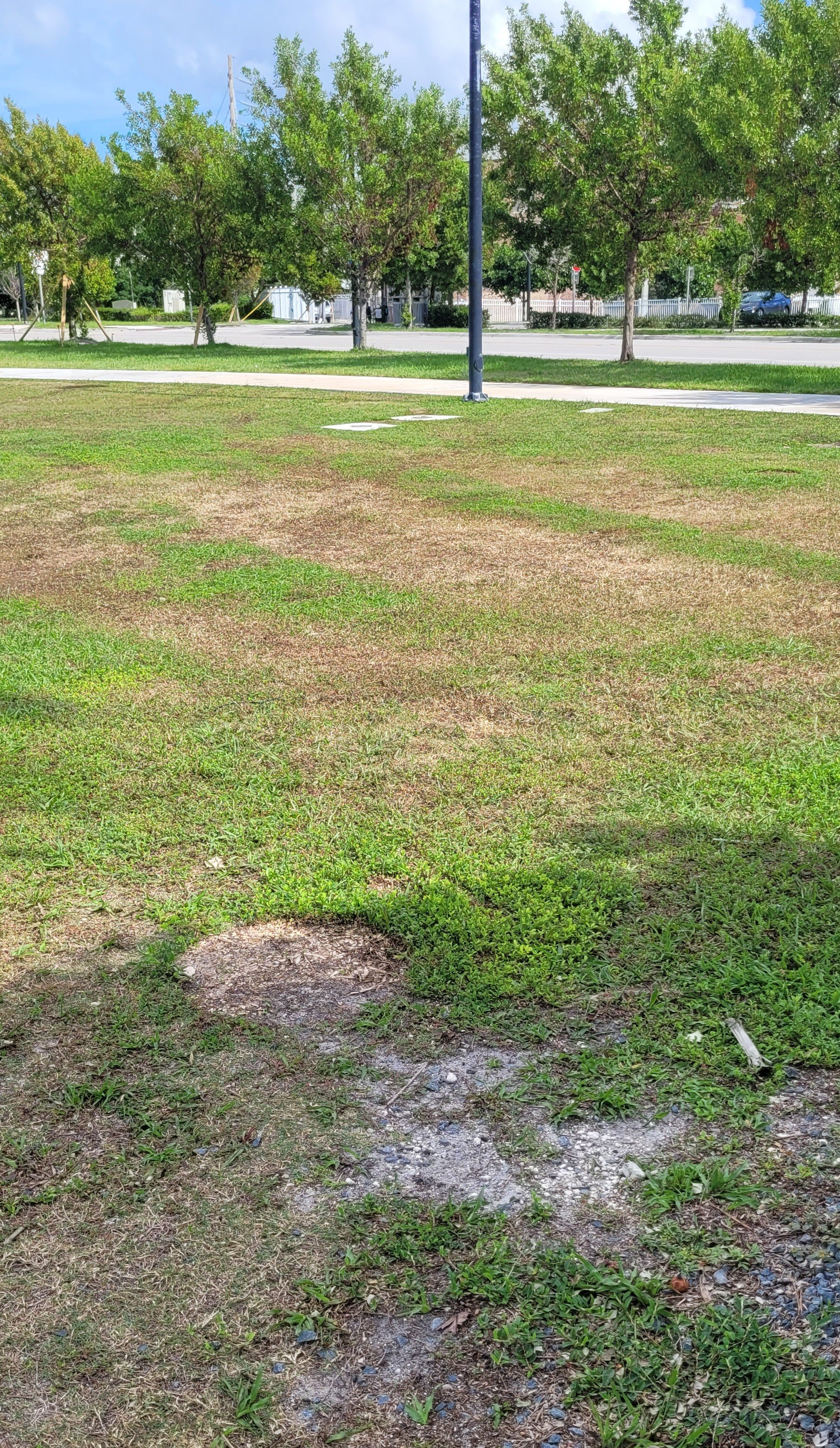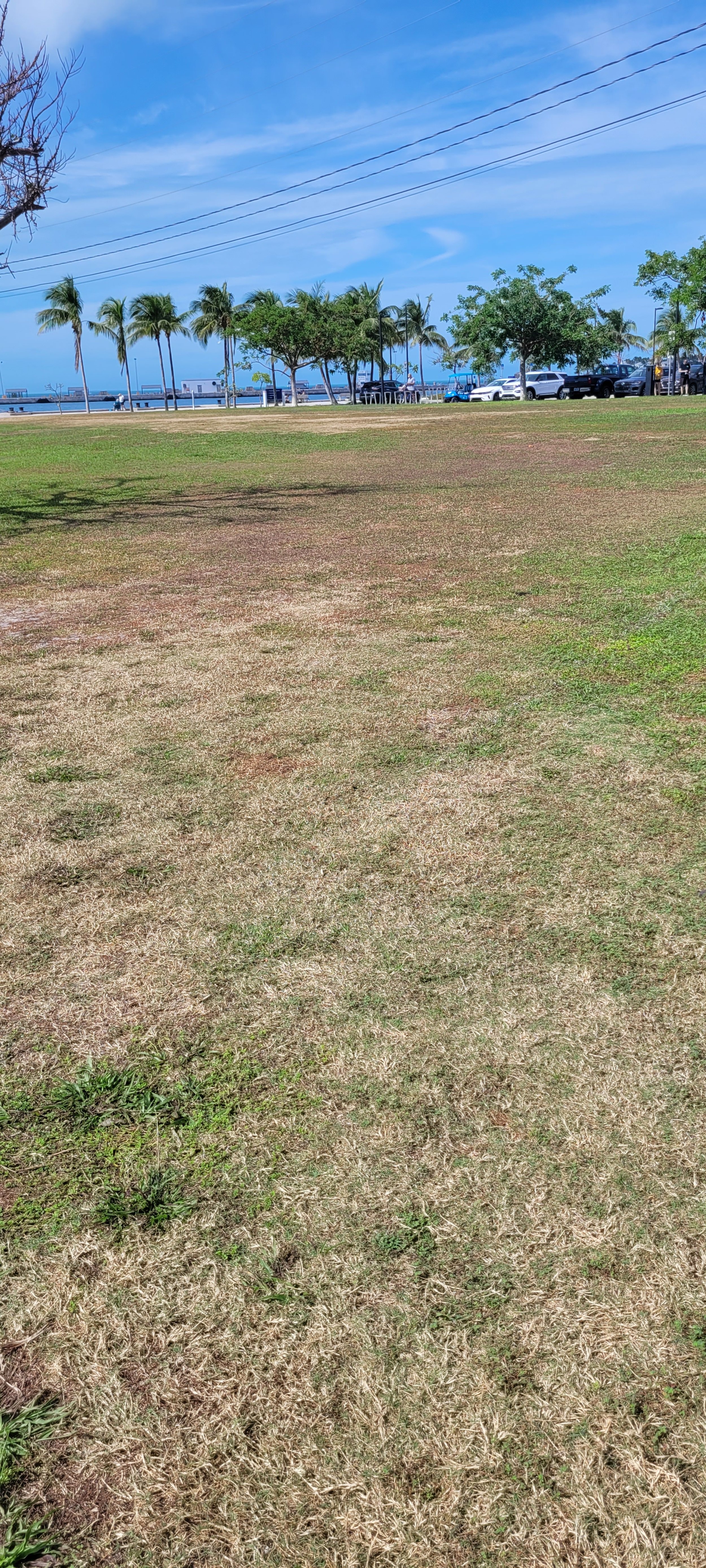Boat Races, Dead Grass and City Neglect
Nearly Eight Months After the Annual Powerboat Races Truman Waterfront Park Still Bears the Scars
Powerboat racing off of Key West has been going on for well over three decades, (although not on the same scale or even using the same course). It is an annual tradition, and reportedly a good source of tourist revenue. But even the best and long-standing of traditions can grow, change, and become more stressful on the infrastructure and quality of life on a small island.
A fairly recent variable in the annual races was the completion of the much anticipated, and long-awaited, Truman Annex (city) Park in 2018. Prior to that time the boat racers basically camped out and conducted their event on unimproved, and not terribly attractive, abandoned Navy property that had been given to the city.
It took the city at least a decade to decide what to do with the property, so the impact that the races had on the land before 2018 was not terribly significant.
Credit: Pixabay stock photo
The second variable, which is probably related to the first (the completion of the park) is that the onshore Race Village (vendor and team camping area) aspect of the event has grown astronomically.
Before the city park was formally developed locals would often walk down to the old quay in front of the harbor to view the sunset, or simply see the water. But it wasn't a terribly attractive place to spend the day. When the park opened, however, it became a favorite place for both locals and visitors to catch the sunset, fish, meet friends and enjoy a rare waterfront location not controlled by private commercial interests.
Unfortunately, over the course of the same five years, the so-called Race Village, which is actually a giant trade show, has come to totally engulf the city park, wreak havoc on the vegetation, block access for ordinary citizens and essentially overwhelm the infrastructure that wasn't designed for such a large event.
Very few people in Key West want to do away with the powerboat races themselves. They do have a long history and they do have their local supporters and fans. Also, the first few weeks of November, after Fantasy Fest, but before Thanksgiving, might be somewhat of a low season without them.
So, it's not a question of whether to have powerboat races or not. But there is a serious question of how much the land-based ancillary (and ever growing) trade show associated with the actual races should be allowed to damage our crown jewel park and exclude locals from enjoying it.
Within these questions are various related issues. Theoretically, Race World Offshore (RWO), the organizer of the event under current city contracts, is supposed to repair any damage to the park. This is not happening. To repeat, this is not happening. And the city has been incredibly dilatory, negligent, and inattentive on that point.
A related issue is the degree to which the city continually undervalues the quality of life for its full time and seasonal residents, in favor of private non local business interests.
There isn't any reason why balancing the interests of locals, and the interests of businesses seeking to make money has to be a zero-sum game. Indeed, at some level, the interests of both groups are always aligned, since a healthy economy is what makes the quality of life residents have in Key West possible.
But balancing interests requires that all stakeholders have a seat at the table. Unfortunately, the everyday citizens who utilize amenities like Truman Annex Park regularly don't have the money and connections that commercial interests possess. It's not so much that the city doesn't care about ordinary citizens. The city bureaucracy just doesn’t tend to think about them much. It is a different matter with those having the resources to ensure that they are heard.
Part of good government should always be to proactively look out for the interests of ordinary citizens who do not possess large war chests and, therefore, special clout.
An amazing oasis for locals and visitors
I've been intimately connected with what is now the Truman Waterfront Park since at least 2005. My spouse bought a house in Truman Annex in 2001. I came into the family in 2005 and began spending weeks at a time here. Over the years we were able to increase our time in Key West and eventually moved here fully.
We used to enjoy walking down to the Navy property when it was not developed. But we were really excited when construction began on the long-awaited city park. And, like virtually every other Key West citizen, we were ecstatic with the outcome.
Despite what the naysayers had to say, it was a well-planned project with well executed construction. We felt, and feel, extremely lucky to live within blocks of such a beautiful oasis.
Prior to the construction of the park, the boat races did sometimes interfere with the ability to access the waterfront. But, it wasn't officially a park then, so wasn't really that much of a loss. And instead of the giant trade show now known as the Race Village, they were just small encampments of race teams. And there was certainly no landscaping to damage.
Fast forward to last November 2022. It had been a good rainy season, including a dousing from Hurricane Ian. The main lawn between the traffic circle, the playground and The Ingham was lush. It was a popular place for yoga, picnics and family birthday parties.
When the trade show (the “Race Village”) arrived in November, it was obvious that the scope of the landward activities has really grown over the years. Virtually every bit of green space was occupied by tents, trailers, and all sorts of structures. The contract with race World offshore requires the organizer to obey all city rules and regulations. But nobody enforced that.
The Zachary Taylor State Park remained open, but the bike lanes were unusable because event goers and vendors were allowed to turn them into parking spaces. A person attempting to use the sidewalks within the village bounds was in constant danger of being run over by a golf cart or even the small pickup truck as these vehicles were allowed to use the sidewalks with impunity.
The city's contract with the organizer specifically states that access to the waterfront will not be impeded. But it was difficult to get to the waterfront due to the extremely large nature of the trade show that had been created. The weekly Farmers Market also did not happen.
I witnessed all of the above personally. I recognize the powerboat races to be a major event enjoyed by locals and visitors alike. So, I wasn't terribly upset about the longstanding event happening. But it was frustrating to lose the concurrent use of a public space that I visit almost every day, especially in the cooler season.
In the old days, it seems that most trailers, booths and tents got by without flooring. But increasingly, the vendors hawking their wares and brands in the Race Village are laying down plywood or even nice tile floors. This is deadly to the grass. Mind you, simply shading the grass with a tent or trailer causes damage. But the grass doesn't necessarily die. Smothering it with an impervious cover, on the other hand, pretty much kills the grass during the eight day period.
I was sick about the damage to the city park (see my Facebook post) but took consolation in the fact that I knew that the city was supposed to require the event organizer to repair any damage "beyond normal wear and tear". I took some pictures of the damage and awaited the repair. Nothing happened.
Thanksgiving came and went. The Christmas season came and went. High season in January and February came and went and the city seemed to show no interest whatsoever and repairing the damage that had been wrought in early November.
I wondered about that. I kept thinking that maybe the city was waiting until after the high tourist season, although that made no sense because the park is actually itself a tourist attraction and it's beauty had been greatly diminished.
Finally in March, I begin to ask questions of the city government. That odyssey is worthy of another entire column. But for this purpose, let it suffice to merely list the journey in trying to get an answer (any kind of answer) from the city.
March 23, 2023 – I sent an initial email to the city department I thought might be in charge of restoring the park. In that message, I requested whoever received it to forward it to the proper department (if I had not selected the right one). The email asked when the restoration of the park would begin and, also, how much money the city had received from the event organizer for use of the park.
March 30, 2023 – Having heard nothing I sent a reminder email asking for a response from the department to which I had directed my initial inquiry.
March 30, 2023 – I received a response advising that “I have forwarded your email to management [presumably in the proper department] to respond”.
March 30, 2023 – I replied, thanking the original correspondent.
[Naively, I was thinking an answer would now be forthcoming.]
April 6, 2023 – Hearing nothing, I went to City Hall and personally asked a city official to follow up with city employees.
April 7 2023 – That official responded via email indicating that: “I have sent this to the city manager, assistant city manager and the community services manager which is in charge of all the parks”.
May 5, 2023 - Still hearing nothing from my original March 23rd inquiry, again I reached out to the city official and ask him if he could advise me exactly who the prior email had been forwarded to.
May 10 2023 - I saw Mayor Terry Johnston at the Business Guild luncheon and explain my situation to her.
Magically, after talking to the mayor, on May 15, 2023 (47 days after my initial email to the city, and 40 days after it has allegedly been forwarded to the proper parties) I finally received a partial response from Marcus Davila, the Director of Community Services for the city.
The response in full was:
My name is Marcus Davila, I am the director of Community Services. I recently received an email concerning some damage to Truman waterfront due to boat races. Last year we did not have any damage to the fields other than normal wear and tear. The previous year we did have a torrential down pore [sic] on race day and there were some ruts put in the grass. Race world offshore immediately called Toppinos and had sand brought down to make the repairs to the ruts within 30 days the park was back to normal.
I was astounded. There wasn't simply a delay and repairing the extensive damage done by the Race Village to key West's premier city park. The community service department actually never intended to repair the damage and, for reasons that remain unfathomable, didn't even see any damage.
Truman Waterfront Park on November 22, 2022, about two weeks after the powerboat races ended
Mr. Davila did not answer my second question about how much money the city had received from the organizers of the event. I knew that the contract called for revenue sharing, whereby the city would receive a certain amount for each admission ticket, parked vehicle and VIP admission sold. (This is independent of the duty to pay for landscape repair.) With the help of assistant city manager Todd Stoughton, I was able to make a public records request and get that information.
The city’s contract with RWO called for:
a) $3.00 per gate admission for each ticket sold for the event; [and]
b) $3.00 per paid parked car in the Truman Waterfront as reflected on attached Exhibits A-I and A-2. $3.00 per VIP ticket sold for the event.
[Odd formatting, but that is how the contract was actually formatted]
The receipt the city provided indicated that RWO paid $3.00 each for 343 general admission tickets on Friday, 410 tickets on Sunday and an additional 365 VIP tickets. There isn’t a record of any payment for vehicle parking as outlined in the agreement. The agreement never even called for payment for use of the space by vendors and visitors simply walking around the “Village”.
In all, RWO paid the city of Key West $3,354 in accordance with its contract with the city.
RWO paid considerably more (over $40,000) for city employee salaries (for those working the event), barricades, trash removal, and rental of the outer mole. There were, I believe, additional charges for security. But those costs were not for use of the park itself. They were pass through costs for services the city provided.
City Provided Receipt Showing $3,354 in “Revenue Sharing”
Whenever economic development arguments are made in favor of the powerboat races and the attendant Race Village, the wealth of the attendees and participants is often touted as a plus. Participants and attendees are said to be (and I have no doubt it's probably true) quite well to do people who are able to spend money in town.
So, for a week of essentially owning almost the entirety of a prime public amenity, RWO paid the city a total of $3,354. Anybody who's walked through the Race Village, observed those utilizing the venue, and speculated about the exact cost of these giant boats and other equipment, might wonder why such people can't pay a reasonable amount. It's not an anti-poverty social welfare organization struggling to get by. (Or a hard strapped downtown restaurant paying a premium for sidewalk space.)
Sigh.
The purpose here is not merely to rant. The situation that happened last November happened. There is no excuse for a city department head to say there was “no damage” when there was clear damage to the landscaping from the event. (Remember, I live within blocks of that park. I'm over there practically every day. I know what condition it is in at any given time.) But, as distressing as that may be, what happened is in the past tense. Right now, what needs to happen is for the city to belatedly address the damage from last year, have a realistic plan to minimize damage this year, and to begin thinking abouts the future.
The current city contract with Race World Offshore (RWO) is for three years and this (2023) is the last year of its three year term. So, it is a great time to re-think the event, the responsibilities of the organizers and the proper compensation for the use of prime (absolutely PRIME) public space by a private enterprise.
Here are some specific suggestions:
May 15, 2023
For 2023 (under the existing contract):
The city needs to fix the damage from last year’s event as soon as possible – even if the chance to have the event organizers pay for it may have passed. Just before last year’s races the lawns were rather lush. I never dreamed that the city would not require any damage to be restored, so, no, I don’t have “before” pictures, other than some incidental photos in the wake of Hurricane Ian a month and a half before the event. (Note to city officials, this will definitely not slip by this year.) I am more than willing to testify under oath that the condition of the lawns before and after the race week and the “before” was in NO WAY comparable to the “afterwards”.
The “after” photographs, including some taken within the past month, are self explanatory.
June 24, 2023
Belatedly repairing the lawn will do several things. It will enhance the appeal and usefulness of the lawns for the summer and fall. Even here in the dog days of heat people use them, especially in the morning, late afternoon, and evening. Also, it will increase the “curb appeal” of our premier city park when families with school children will be visiting. More importantly, having a proper baseline will allow the city to properly assess the damage that is caused by this year’s event. Allowing the damaged condition from last year to be the new norm will make it difficult to assess repair costs this year.
The city needs to clamp down on grass killing impervious flooring under tents and booths. That is the thing that is most deadly to grass. It is a lawn. Sure, it is going to take a beating just from shading and foot traffic. But there is no need to make it worse than it has to be.
Traffic and parking rules need to be enforced. The park is supposed to remain open for residents and visitors, as well as race attendees and vendors. Allowing golf carts, small cars, and trucks to drive on the internal sidewalks is not acceptable and dangerous for everyone. Likewise, the bicycle lanes are not parking spaces. In such a crowded situation they are, in fact, crucial to conducting the large number of tourists cycling from “town” to Zach Taylor Park.
After this fall’s event, the city needs to take seriously its responsibility to see that the inevitable damage to the park is repaired (as REQUIRED under the current contract). No more waving off obvious damage as “normal wear and tear.”
Beyond this year, the city needs to think carefully about how to bring more balance to the race week situation. The powerboat races are an established tradition. The event apparently is good for business in town. It has many local fans. But the land based part of the event has grown way beyond what it was just ten or so years ago. Moreover, its traditional venue is no longer a wasteland of abandoned Navy property. The interests of the community, the ability of locals to access their public park and the need to preserve the park also need to be part of the discussion.
People come to the races to see the races. What happens on the water may or may not have environmental consequences. (That is a discussion others may want to pursue.) This discussion is about what happens on land. The Race Village has been able to expand beyond the carrying capacity of the city park. It is now primarily a vendor exhibition site (rather than a race support site). It certainly can’t claim to be a longstanding event in its current configuration, and it can be scaled back without affecting the races themselves.
Truman Waterfront Park Is A Gem Worth Protecting
The last time a new contract was negotiated the city put out a RFP and the competition to host the event was stiff. Protecting the physical environment of the park should be a major consideration in considering future contracts and RFPs. It should play a major role in evaluating proposals. The overall health of the park seems to be an afterthought now - if it is considered at all.
The participants and organizers of the powerboat races are not starving artists. It is one of the richest events in south Florida, attended by some of the richest people in the country and featuring very high end teams and vendors. They can afford to spend more than $3,354 for the nearly unfettered use of one of the most prime bits of real estate in the Keys. Enough said on that point. They can certainly also afford to pay for the damage they cause. Their time in the public space is shared time with local residents, not as an exclusive tenancy.
Balance. It’s an elusive goal when rich powerful special interests, backed by powerful local politicians, hold sway. But it is achievable. Let’s make it happen for our park going forward.












